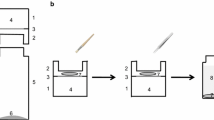Abstract
The fine structure and monomeric composition of the ester-cutin fraction (susceptible to BF3/CH3OH transesterification) of the adaxial leaf cuticle of Clivia miniata Reg. were studied in relation to leaf and cuticle development. Clivia leaves grow at their base such that cuticle and tissues increase in age from the base to the tip. The zone of maximum growth (cell expansion) was located between 1 and 4 cm from the base. During cell expansion, the projected surface area of the upper epidermal cells increased by a factor of nine. In the growth region the cuticle consists mainly of a polylamellate cuticle proper of 100–250 nm thickness. After cell expansion has ceased both the outer epidermal wall and the cuticle increase in thickness. Thickening of the cuticle is accomplished by interposition of a cuticular layer between the cuticle proper and the cell wall. The cuticular layer exhibits a reticulate fine structure and contributes most of the total mass of the cuticle at positions above 6 cm from the leaf base. The composition of ester cutin changed with the age of cuticles. In depolymerisates from young cuticles, 26 different monomers could be detected whereas in older ones their number decreased to 13. At all developmental stages, 9,16-/10,16-dihydroxyhexadecanoic acid (positional isomers not separated), 18-hydroxy-9-octadecenoic acid, 9,10,18-trihydroxyoctadecanoic acid and 9,10-epoxy-18-hydroxyoctadecanoic acid were most frequent with the epoxy alkanoic acid clearly predominating (47% at 16 cm). The results are discussed as to (i) the age dependence of cutin composition, (ii) the relationship between fine structure and composition, (iii) the composition of the cuticle proper, the cuticular layer and the non-depolymerizable cutin fraction, and (iv) the polymeric structure of cutin.
Similar content being viewed by others
Abbreviations
- CL:
-
cuticular layer
- CP:
-
cuticle proper
- MX:
-
cutin polymer matrix
References
Croteau, R., Kolattukudy, P.E. (1975a) Biosynthesis of hydroxyfatty acid polymers. Enzymatic epoxidation of 18-hydroxyoleic acid to 18-hydroxy-cis-9,10-epoxystearic acid by a particulate preparation from spinach (Spinacia oleracea). Arch. Biochem. Biophys. 170, 61–72
Croteau, R., Kolattukudy, P.E. (1975b) Biosynthesis of hydroxyfatty acid polymers. Enzymatic hydration of 18-hydroxy-cis-9,10-epoxystearic acid to threo-9,10,18-trihydroxystearic acid by a particulate preparation from apple (Malus pumila). Arch. Biochem. Biophys. 170, 73–81
Holloway, P.J. (1982a) The chemical constitution of plant cutins. In: The plant cuticle, pp. 45–84, Cutler, D.F., Alvin, K.L., Price, C.E., eds. Academic Press, London New York
Holloway, P.J. (1982b) Structure and histochemistry of plant cuticular membranes. In: The plant cuticle, pp. 1–32, Cutler, D.F., Alvin, K.L., Price, C.E., eds. Academic Press, London New York
Holloway, P.J. (1984) Cutins and suberins, the polymeric plant lipids. In: CRC handbook of chromatography, lipids, vol. 1, pp. 321–345, Mangold, H.K., Zweig, G., Sherma, J., eds. CRC Press, Boca Raton
Kolattukudy, P.E. (1981) Structure, biosynthesis and biodegradation of cutin and suberin. Annu. Rev. Plant Physiol. 32, 539–567
Kolattukudy, P.E., Purdy, R.E., Maiti, I.B. (1981) Cutinases from fungi and pollen. Methods Enzymol. 71, 652–664
Lendzian, K.J., Schönherr, J. (1983) In-vivo study of cutin synthesis in leaves of Clivia miniata Reg. Planta 158, 70–75
Mérida, T., Schönherr, J., Schmidt, H.W. (1981) Fine structure of plant cuticle in relation to water permeability: The fine structure of the cuticle of Clivia miniata Reg. leaves. Planta 152, 259–267
Riederer, M., Schönherr, J. (1986a) Quantitative gas chromatographic analysis of methyl esters of hydroxy fatty acids derived from plant cutin. J. Chromatogr. 360, 151–161
Riederer, M., Schönherr, J. (1986b) Covalent binding of chlorophenoxyacetic acids to plant cuticles. Arch. Environ. Contam. Toxicol. 15, 97–105
Riederer, M., Schönherr, J. (1988) Covalent binding of chemicals to plant cuticles: Quantitative determination of epoxide contents of cutins. Arch. Environ. Contam. Toxicol. 17, 21–25
Riley, R.G., Kolattukudy, P.E. (1975) Evidence for covalently attached p-coumaric acid and ferulic acid in cutins and suberins. Plant Physiol. 56, 650–654
Schmidt, H.W., Mérida, T., Schönherr, J. (1981) Water permeability and fine structure of cuticular membranes isolated enzymatically from leaves of Clivia miniata Reg. Z. Pflanzenphysiol. 105, 41–51
Schmidt, H.W., Schönherr, J. (1982) Development of plant cuticles: occurrence and role of non-ester bonds in cutin of Clivia miniata Reg. leaves. Planta 156, 380–384
Schönherr, J., Riederer, M. (1986) Plant cuticles sorb lipophilic compounds during enzymatic isolation. Plant Cell Environ. 9, 459–466
Zhu, A. (1985) Calculation of retention indices in temperature-programmed capillary gas chromatography. J. Chromatogr. 331, 229–235
Author information
Authors and Affiliations
Rights and permissions
About this article
Cite this article
Riederer, M., Schönherr, J. Development of plant cuticles: fine structure and cutin composition of Clivia miniata Reg. leaves. Planta 174, 127–138 (1988). https://doi.org/10.1007/BF00394885
Received:
Accepted:
Issue Date:
DOI: https://doi.org/10.1007/BF00394885




